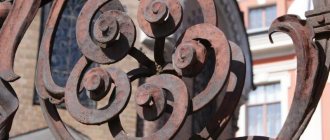Forged roses in a cemetery
Flowers in a cemetery symbolize the transience of our life - this is an expression of your feelings for the deceased, saying that he is not forgotten, and we are still loved.
Natural flowers, unfortunately, wither very quickly, and artificial ones lose their appearance after the first rainfall, wind, or sunlight. And I really want the grave of a loved one to be decorated with beautiful, noble flowers, for example, roses.
Roses, in the ritual sphere, are a symbol of deep, sincere feelings, eternal memory and sorrow. Therefore, your love and respect for the deceased can be expressed through these symbolic details. They not only express your feelings, but also decorate the burial and attract the attention of passers-by.
Preparation of materials and equipment
What materials will you need:
- Sheet metal is usually used for the petals and leaves. The thickness and type of metal is a matter of taste and choice of the craftsman, but most often a sheet with an average thickness of 0.5 mm is taken. It can be cold-rolled black metal, or it can take metal from the hood or fenders of a car - it is quite thin there - up to 0.8 mm.
- For stems you need to find a suitable wire with a diameter of 5 mm or more; for options with spikes, a knitting wire with a diameter of 6 mm is more suitable - this work is more difficult. You can use rods with a diameter of 8 to 12 mm.
The tools you will need are the simplest:
- Welding machine: better semi-automatic or inverter with 2 mm electrodes at a current of no more than 70 A.
- Grinder or grinder, metal scissors, pliers.
- Gas-burner.
- Drill with drill bits for metal from 0.5 to 1.0 cm.
- Unrefined or motor oil for finishing rose bluing.
- Metal paints, if the rose needs to be painted.
Forging
Forging a rose using this method uses all the skills of blacksmithing and the appropriate tools.
In essence, the basic technology is similar to that described in the previous section with the addition of basic Kuznetsk operations.
You will need rolled stock in the form of a 6 mm rod and 2-2.5 mm sheet steel for blanks for the petals of the future flower.
The rod is heated at one end and the edge is thickened. This can be done by holding it in a vice and using blows from the end to form a thickening.
To conveniently secure the petals around the thickening circle of the rod, you can make a groove with a chisel on the heated metal.
Blanks in the form of petals and crosses are cut from sheet steel in the same way as in the above method.
Each of the petals is pre-forged and thinned at the edges, dispersing the metal. At the same time, you can still create the veins inherent in a natural rose.
Before assembly, you can make thorns on the stem. To do this, you need to make thickenings on the rod using the planting technique, which are then, after securing the stem in a vice, formed into spikes.
Start assembling the flower from the prepared elements.
Each of the four-lobed parts is placed on a rod and welded. In this case, each element must be scrolled, making the desired shape. Also, after assembly, using pliers, give the product the desired volume and contours.
If you wish, you can also attach foliage to the stem. Each leaf is produced using the blacksmith method from a 2 mm steel sheet. A cutting is pulled from it, which is used to attach the element to the stem.
At the end of the work, the flower is cleaned of slag and soot.
You can also do a type of finishing such as bluing. To do this, you will need to apply a thin layer of unrefined oil to the product and heat it in the oven until the applied ingredient is covered with a varnish crust.
As a result of such blacksmithing “floriculture” the following result should be obtained:
Forged plants will make the interior unique
Nowadays, elegant forged interior items continue to remain relevant. Despite the dominance of cutting-edge decorating styles, many are still drawn to traditional decorations. Just one forged rose, forged lily or carnation, placed on a closet shelf or on a coffee table, will add a touch of mysterious romance to the decor. Forged daisies in a vase look very unusual. This will enliven not only the home interior, but also a strict office.
Forged plants, especially forged flowers, are not difficult to buy: inexpensive models, the manufacturing process of which is partially automated, are available in many retail outlets. However, the most amazing forged products are those that are made by hand from start to finish. They are especially attractive due to their uniqueness - after all, the soul of the author is invested in each work. These are the forged flowers that our company offers.
Forged roses for the grave
In ours you can order forged roses for the grave, made by hand using the artistic forging method. Metal roses forged by our blacksmiths are realistic and very similar to real flowers.
At your request, we will paint the roses in any color to make them more natural. Particularly durable, bright paint made in Italy will convey all the beauty of living plants.
Symbolism of color:
- Red – divine love, rebirth, triumph of life over death;
- White – angelic purity, innocence, peace, serenity;
- Yellow, also known as gold – the greatness of the Holy Spirit, power, glory, eternal life, divine revelation;
- Green is the natural vital force of rebirth, awakening from hibernation, but it is also a symbol of temptation;
- Black is the color of death, a symbol of mourning, sorrow, suffering.
A metal bouquet of several roses looks very harmonious in a cemetery. These flowers are not afraid of rain, wind or frost; they will not fade under the scorching sun.
A special, anti-corrosion alloy used for forging extends the service life of metal rosettes. Often combined flowers are ordered: the stem and petals are made of anti-corrosion steel, and the petals are made of non-ferrous metal. For example, from copper, brass, bronze, cupronickel and other non-ferrous alloys.
Artistic floriculture: design stage
The fact that it is necessary to clean up weld marks and take measures to protect against corrosion is clear - it is not subject to discussion. But further design processing raises many questions. The fact is that blacksmiths and welding masters are happy to make metal roses and post videos with master classes and their photographs on the RuNet. Everyone has their own technical discoveries and style of execution - roses with buds, fully opened, with and without thorns - excellent tips and step-by-step guides, choose any.
Meanwhile, modern design fashion for eclecticism in all applied directions gives freedom and enormous possibilities in the color and texture design of metal flowers. But in any case, the forged rose will remain special and unique - the main flower of a huge army of blacksmith and welding masters. Join us and make your own rose.
Cutting without sewing, technical stages of work
The process of creating a rose:
Making a solid forged rose.
- From sheet metal we cut out four or five, if we want a larger rose, square templates with a side length of 10 cm. In each square we draw a schematic flower with four petals, try to draw them symmetrical, but precision to the millimeter is not needed here. On the last square we draw a sepal that looks like a compass rose; exact symmetry is not necessary here either.
- If you want to make a tea rose - wide open, with numerous petals, it is better not to be lazy and prepare the templates in the following order:
- The sepal is a five-pointed star with a diameter of 7–8 cm.
- The first outer blank consists of five petals with a diameter of 11 - 12 cm.
- The second and third blanks each have four petals with a diameter of 10–11 cm.
- The fourth blank is made of three petals with a diameter of 10 cm.
- The fifth is made of four narrow petals with a diameter of 9 cm.
- We cut out the blanks with metal scissors or, if available, with an angle grinder. We do not cut to the center of the figure.
- We draw on the metal a couple or three blanks for green leaves on the stem. The size must be different. We cut out the leaves with scissors or a grinder.
- Let's take the stem. If it is a rod, shorten it to 40 - 50 cm.
- We drill holes in the blanks to attach them to the stem. The diameters of the holes and the stem blank must match. The rod or wire should fit tightly into the petals.
- Welding stage: weld the workpieces to the stem. The optimal thickness of the electrode is 3 mm, the current strength is from 70 to 100 A. The holes in the petals do not have to be made round, the main thing is that the stem touches them with at least half of its circumference. In this case, the seam and the structure itself will be strong. You need to melt more rods than petals - it’s easy to burn through thin metal.
Now comes the most exciting and artistic part of the work: forming the rose petals! We bend the leaves of the sepals of the lower workpiece down. Turn on the gas burner and begin to gradually heat the flat petals. At this stage, moderate heating is sufficient - there is no need to heat it red-hot. We use pliers to wrap the two petals as if we were wrapping them into each other. We wrap the remaining two petals around the first two. We work like this with each layer. At the same time, we bend the tips of each petal outward - in the opposite direction. At this stage, it is important to have a “free” hand: the petals should be crooked, their bends in the opposite direction should be unequal, the serifs and marks should be asymmetrical. This is the only way the flower will turn out alive and real: there are no strict geometric shapes in nature. Let's start with the leaves on the stem. We make small notches on each edge of the leaves. The leaves should not be flat, just bend them with your hands
We weld it to the stem carefully at the weld points. In principle, the rose is ready. But only in principle!
https://www.youtube.com/watch?v=MbQ8wjkkzPw
How to choose forged products for flowers
The stands are available as floor, wall or tabletop. The design allows not only to plant greenery, but also saturates the corner with a unique atmosphere. Forged elements are beautiful in themselves, and together with lively colors a complete picture is created. When choosing a suitable design, you will need to take into account the features of caring for plants: how much light, space, etc. are needed.
Wall stands are the most economical. They do not take up much space and can dilute the appearance of the walls. The design makes the room cozier, largely due to its combination with colors.
Stands come in different types, for example, they are made as an elongated shelf that runs along the entire wall, or they are extended along the sides to take up space on all planes. The forging pattern must correspond to the shape of the flower: for vines and climbing sprouts, a solution of vertical and beveled lines is suitable, for azaleas or violets - with swirls and metal leaves. For simple plants, complex stands with an abundance of patterns would be appropriate.
Desktop products must have appropriate furniture additions: tables, cabinets on which you can install a stand
It is important to consider that the usable space in the room is reduced. Tabletop variations are suitable for spacious rooms, for example, halls or guest rooms
Floor structures look more massive and solid than others. They become a separate piece of furniture and give the environment a completely different character. Wide stands, similar in appearance to whatnots, allow you to install several flowerpots in rows. When distributing plants, you need to remember the rule: at the top there are climbing flowers that are most sensitive to light, and at the bottom there can only be undemanding species.
Plants add vitality to a room, filling it with fresh air and energy. However, empty pots do not often fit into the interior, so forged flower products come to the rescue.
Forged flowers are an ideal gift
Presenting a luxurious bouquet as a gift has long become a tradition. But the cut plants quickly wither, but you want the gift to please you for a long time. Forged flowers will come to the rescue in this case too. It’s hard to think of something better for a loved one – after all, exquisite creations will not only bring joy on a memorable day, but will also become real family heirlooms.
The price largely depends on the complexity of the work, the material, and production time. Ancient traditions combined with modern technologies work wonders. Each flower delights with its perfection of execution. Graceful inflorescences can form a whole composition - the idea of creating a forged ikebana for your home is tempting. Such a bouquet will always delight with its pristine beauty, and the interior will never lose its elegance and expressiveness.
Video of the process of making forged roses in our forge
And yet, for whom are we creating these roses?
- Firstly, a forged rose is the best gift for your beloved. Because there is no more romantic way to confess your love to her than to say that you will love her until this rose withers.
- Secondly, this is a royal gift for the most gentle, most refined natures, connoisseurs of everything beautiful and unusual, for women. Mom, sister, daughter, distant relative, your colleague at work, friend and just a friend will be delighted with such a rose.
- Thirdly, this is an unusual gift for those who do not like boring interiors. Such a rose will dilute any interior and will definitely become the center of attention.
- Fourthly, this rose is for practical people. After all, many people love Flowers, but are very upset when they wither. Our rose will never wither; it can be passed on to generations.











